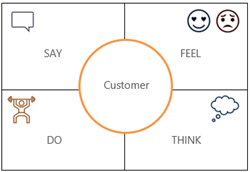What are empathy maps?
12/1/20 / Molly Hagan


They say data is more valuable than gold these days. Every action we take online or on our phones provides data points that go on to help targeted advertising and marketing initiatives, among other things. Companies and purpose-driven organizations have more information about their customers than ever, but yet, do they really understand their customers? And what does it mean to understand a customer? What does it look like to embrace a customer mindset to try to actually empathize with your customer’s experience?
Corona’s Karla Raines has embraced the customer mindset in Differentiation Zone, her proprietary and innovative approach to strategy for purpose-driven organizations. She notes that it is essential to take a customer mindset when setting a strategy, arguing, “[a] customer mindset is the holistic understanding of your customer. When you embrace your customer’s mindset, you appreciate the intrinsic link between the rational and the emotional. You care about what your customer cares about.”
You may be familiar with the term journey mapping. Marketing and research professionals alike have turned to journey maps to understand the customer, target audience, or user. Journey maps are just one type of what is commonly referred to as “user experience maps”. A less well-known, but still helpful, user experience map is called an empathy map. In this blog, we will talk about when and why to use empathy maps in your research or strategic engagements.
Empathy maps help create and cultivate empathetic understandings about audiences and customers within teams. This alignment can go on to inform organizational strategies or even innovation. But what exactly is an empathy map? The Nielson Norman Group, largely considered the go-to experts in user experience research, defines empathy maps as “…a collaborative visualization used to articulate what we know about a particular type of user.” Importantly, an empathy map is designed for use with one type of customer, user, or persona. Other key attributes of empathy maps are that they are not chronological. Unlike their more well-known journey maps, empathy maps are not intended to show customer behavior over time or through an experience. It is instead a snapshot of the user at a single point in time and context.
Empathy maps lay out four key questions: What is your customer thinking, feeling, doing, and saying? Using these four questions to frame your understanding can help ensure further research objectives and implementation make sense. The below chart is just one template any researcher can use when creating an empathy map.

Now that you understand the basic components of what makes up an empathy map, you may be wondering what kind of research project would this be ideal for? What types of questions can it answer? Come back for part 2 of our empathy map blogging to see an example of how an empathy map can be put to use.